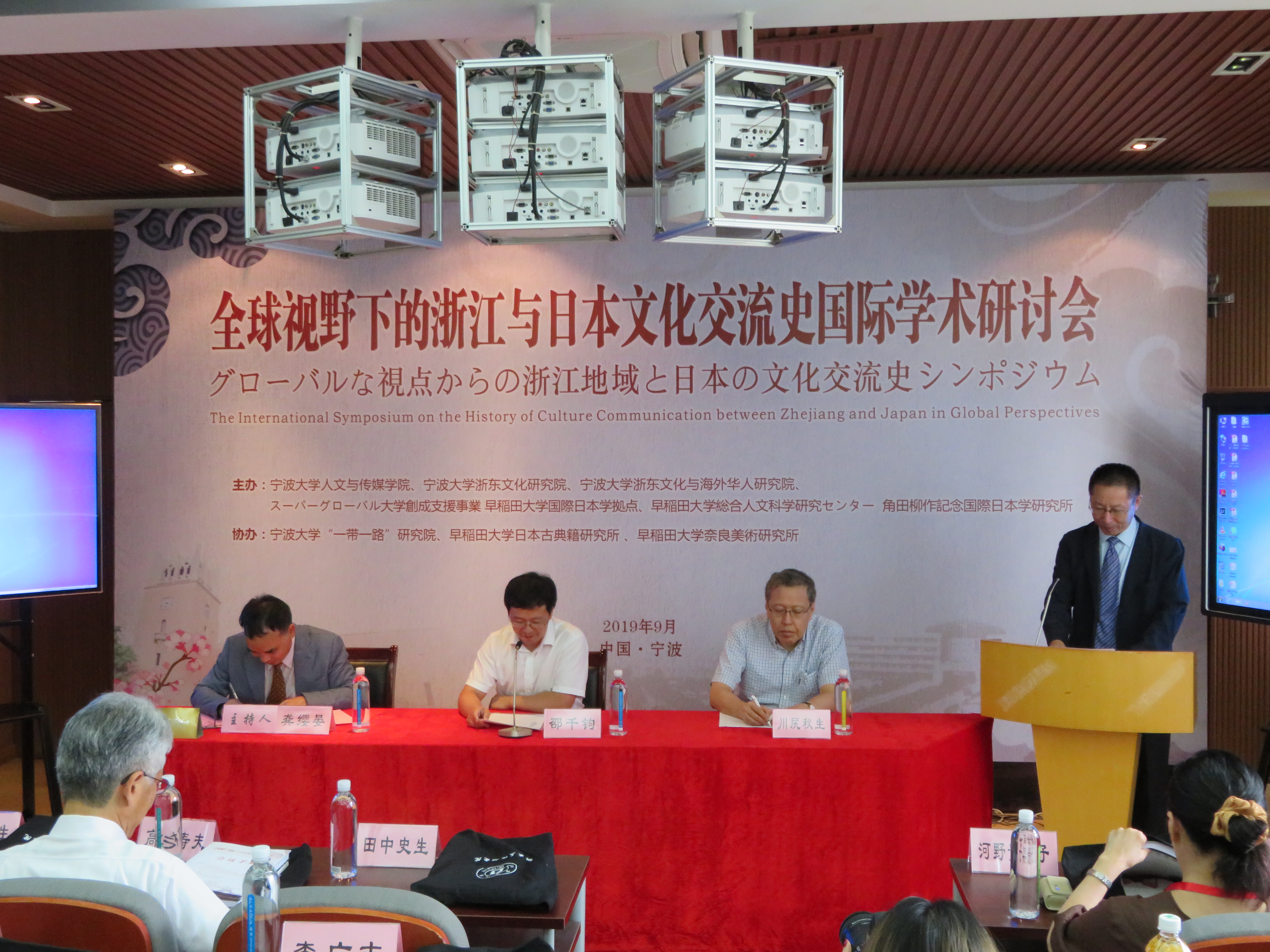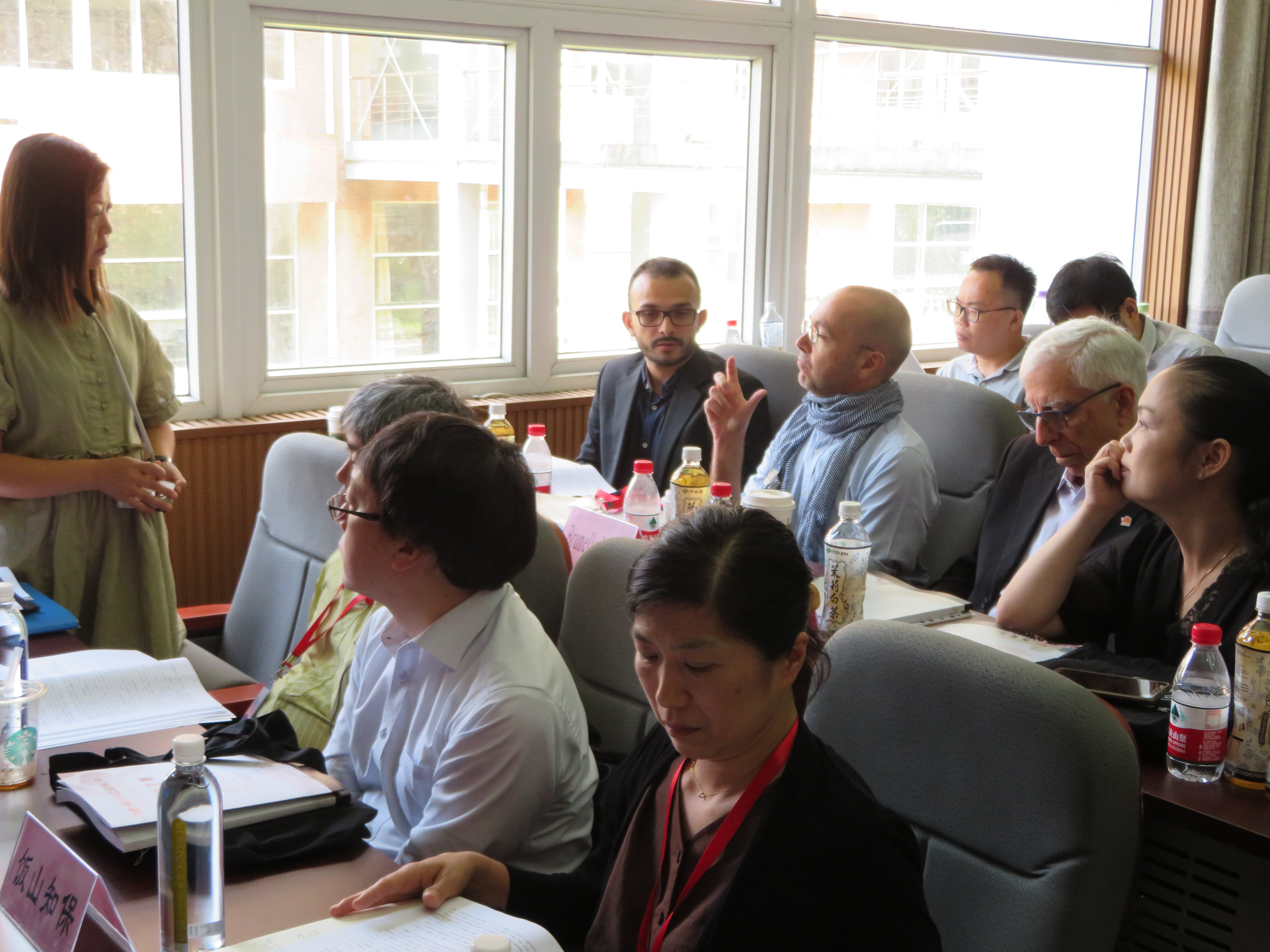A three-day international symposium, “The History of Culture Communication between Zhejiang and Japan in Global Perspectives,” took place from September 5 to 7, 2019, in the city of Ningbo, China. The objectives of the symposium were to shine a spotlight on the Zhejiang region, where various Asian and European relationships intertwined and which served as a crucial access point linking Japan and China, to illuminate historical/literary regional linkages and interactions involving Asian regions including Japan, and to decipher the diverse, cross-boundary, and regional aspects of Japanese history and literature within the context of world history. Another aim of the event was to build relationships with major educational and research institutions and scholars in the Ningbo region, which is home to a wealth of historical materials relating to the history of Japan-China relations.
The symposium began at Ningbo University with four sessions held over the two days of September 5 and 6, at which research presentations and discussions took place. Fifteen scholars from Japan, China, and Europe reported on research findings, and the sessions were attended by another 40 scholars from China and Europe, as well as by 70 students studying at Ningbo University, making for a lively event.

Opening Remarks

Discussion Session
During the first session September 5, four scholars gave presentations while referring to specific historical documents: Yu Dong from the Vatican Apostolic Library discussed documents relating to Japanese history from the library’s archives, Brunello Mauro from the Archivum Romanum Societatis Iesu presented on documents from that institution’s holdings, Fumio Tanaka of Waseda University described the conditions of trade with Japan by Jiangnan-area merchants during the Tang Dynasty, and Lin Tian-ren of the National Palace Museum in Taipei discussed exchanges between the East and the West in relation to maps. During the second session, Akio Kawajiri of Waseda University described features of, and the Chinese influence on, the forms that documents took in Japan in antiquity and the feudal era, J. Luiz Lima of Salesian Pontifical University in Rome discussed the role of Latin in the study of Chinese-derived words in Japanese, and Tomoyasu Iiyama of Waseda University presented on issues concerning the academic theory of the “Tang-Song Transition.” During the third session, Hisao Takamatsu of Waseda university presented on perceptions of “Jiangnan” in eighth-century Japan, Li Guang-zhi of Ningbo University discussed the placement of Ningbo-Japan relations within East-Asian history, and Kimiko Kono of Waseda University spoke about the writings of Japanese emissaries to the Ming Dynasty in Ningbo. Finally, during the fourth session on September 6, Pierre Emanuel Roux of Université Paris Diderot spoke about the influence of the Japanese practice of fumie as a religious test on systems of restricting Christianity during parts of China’s Qing era, Kenji Igawa of Waseda University discussed the presumed location of the place known as “Liampo” that appears in historical materials from Europe and North America, Gong Ying-yan of Ningbo University talked about the presumed location of the “Port of Shuangyu” seen on old maps, Liu Heng-wu of Ningbo University described the relationship between Keizan’s Rules of Purity and similar Buddhist sectarian regulations by Dogen, and Zheng Le-jing discussed the status of research into uncovering the truth of incidents of Chinese people being slaughtered in the aftermath of the Great Kanto Earthquake of 1923. At the end of each session there was a discussion period, during which the Ningbo University students posed a variety of questions; the discussions went as far as touching upon issues concerning the current state of history education in Japan. Afterward, Gong Ying-yan and Fumio Tanaka provided overall commentary on the sessions, as a whole.
On the afternoon of September 6, the event moved to the Tianyi Pavilion Museum, where Zhou Hui-hui and Li Kai-sheng of the museum described its collection of historical materials. Afterward, those in attendance were shown originals of the Tiansheng Code and other documents in the museum’s collection that have had a great influence on research into historical codes of law in Japan, and a discussion centered on the objectives of the symposium took place. On September 7, Ningbo University’s Gong Ying-yan led the participants and attendees of the symposium to view stone inscriptions by Hakata merchants unearthed in Ningbo and other historical materials that relate to Japan in the collection of Ningbo University’s museum and to engage in further discussion. There were also trips taken to survey the Temple of King Ashoka and Tiantong Temple; there were exchanges of views, prompted chiefly by stone inscriptions at the two temples, on the relationship between Buddhism in Ningbo and Buddhism in Japan. Tiantong Temple had been severely damaged by heavy rains brought by typhoons in August, and thus there was also a discussion of the importance of preserving cultural assets.
Through the events mentioned above, it was affirmed in specific terms that the historical and cultural ties between Japan and the Zhejiang region should be considered within the context of a spatial expanse that extends as far as Europe and that one must be aware that these ties have been conveyed to later generations through processes of selective memory that have tinged the ways in which they have been perceived in different eras. Furthermore, it became manifest that Ningbo has played a crucial role in such exchanges. Thus, there was also discussion about how Ningbo became for such a long period a locus for exchanges among peoples of Asia, including from Japan. However, a clear conclusion could not be reached concerning this question during the symposium. It is expected that shedding light on this question is what scholars should turn their attention to next.
Overview of the Symposium
Title:“The History of Culture Communication between Zhejiang and Japan in Global Perspectives”
Dates: September 5 to 7, 2019
Venues: School of Humanities and Communications, Ningbo University; Tianyi Pavilion Museum; Ningbo Museum; the Temple of King Ashoka; Tiantong Temple
Presenters:
Yu Dong (Vatican Apostolic Library)
Brunello Mauro (Archivum Romanum Societatis Iesu)
Fumio Tanaka (Waseda University)
Lin Tian-ren (National Palace Museum, Taipei)
Akio Kawajiri (Waseda University)
J. Luiz Lima (Salesian Pontifical University, Rome)
Tomoyasu Iiyama (Waseda University)
Hisao Takamatsu (Waseda University)
Li Guangh-zhi (Ningbo University)
Kimiko Kono (Waseda University)
Pierre Emanuel Roux (Université Paris Diderot)
Kenji Igawa (Waseda University)
Gong Ying-yan (Ningbo University)
Liu Heng-wu (Ningbo University)
Zheng Le-jing (Ningbo University)
*Names provided in the order presentations were given
Moderated by:
Wang Hai-yan (Zhejiang University)
Carlo Socol (Salesian Pontifical University, Rome)
Pierre Emanuel Roux (Université Paris Diderot)
Kimiko Kono (Waseda University)
*Names provided in the order in which duties were conducted
Languages used: Japanese, Chinese, English
Intended participants: Scholars and students
Sponsored by:
Waseda University Global Japanese Studies Model Unit, Top Global University Project
Waseda University Research Institute for Letters, Arts and Sciences and the Ryusaku Tsunoda Center of Japanese Culture
Institute for East Zhejiang Culture Studies, Ningbo University
Institute for East Zhejiang Culture and Overseas Chinese Studies, Ningbo University
School of Humanities and Communications, Ningbo University
Co-sponsored by:
Waseda University Research Institute of Japanese Classical Books
Research Institute of NARA BIJUTSU, Waseda University



